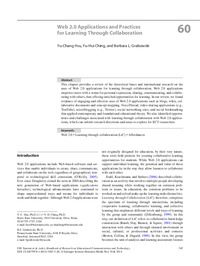Web 2.0 Applications and Practices for Learning Through CollaborationYu-Chang Hsu, Yu-Hui Ching, Barbara Grabowski
Zu finden in: Handbook of Research on Educational Communications and Technology (Seite 747 bis 758), 2014
|
 |
 Diese Seite wurde seit 2 Jahren inhaltlich nicht mehr aktualisiert.
Unter Umständen ist sie nicht mehr aktuell.
Diese Seite wurde seit 2 Jahren inhaltlich nicht mehr aktualisiert.
Unter Umständen ist sie nicht mehr aktuell.
 Zusammenfassungen
Zusammenfassungen
 This chapter provides a review of the theoretical bases and international research on the uses of Web 2.0 applications for learning through collaboration. Web 2.0 applications empower users with a venue for personal expression, sharing, communicating, and collaborating with others, thus offering enriched opportunities for learning. In our review, we found evidence of engaging and effective uses of Web 2.0 applications such as blogs, wikis, collaborative documents and concept mapping, VoiceThread, video sharing applications (e.g., YouTube), microblogging (e.g., Twitter), social networking sites, and social bookmarking that applied contemporary and foundational educational theory. We also identified opportunities and challenges associated with learning through collaboration with Web 2.0 applications, which can inform research directions and areas to explore for ECT researchers.
This chapter provides a review of the theoretical bases and international research on the uses of Web 2.0 applications for learning through collaboration. Web 2.0 applications empower users with a venue for personal expression, sharing, communicating, and collaborating with others, thus offering enriched opportunities for learning. In our review, we found evidence of engaging and effective uses of Web 2.0 applications such as blogs, wikis, collaborative documents and concept mapping, VoiceThread, video sharing applications (e.g., YouTube), microblogging (e.g., Twitter), social networking sites, and social bookmarking that applied contemporary and foundational educational theory. We also identified opportunities and challenges associated with learning through collaboration with Web 2.0 applications, which can inform research directions and areas to explore for ECT researchers. Dieses Kapitel erwähnt ...
Dieses Kapitel erwähnt ...
 Begriffe KB IB clear | microbloggingmicroblogging |
 Anderswo finden
Anderswo finden
 Volltext dieses Dokuments
Volltext dieses Dokuments
 |  Web 2.0 Applications and Practices for Learning Through Collaboration: Artikel als Volltext bei Springerlink ( Web 2.0 Applications and Practices for Learning Through Collaboration: Artikel als Volltext bei Springerlink ( : :  , 249 kByte; , 249 kByte;  : :  2020-11-28) 2020-11-28) |
 Anderswo suchen
Anderswo suchen 
 Beat und dieses Kapitel
Beat und dieses Kapitel
Beat hat Dieses Kapitel während seiner Zeit am Institut für Medien und Schule (IMS) ins Biblionetz aufgenommen. Beat besitzt kein physisches, aber ein digitales Exemplar. Eine digitale Version ist auf dem Internet verfügbar (s.o.). Aufgrund der wenigen Einträge im Biblionetz scheint er es nicht wirklich gelesen zu haben. Es gibt bisher auch nur wenige Objekte im Biblionetz, die dieses Werk zitieren.










 Biblionetz-History
Biblionetz-History